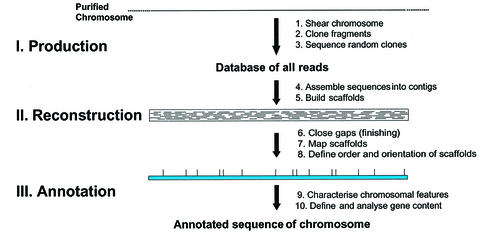Fig. 2. Steps in a WCS approach. Three main phases, production, reconstruction and annotation, are distinguished. The starting material is a purified chromosome, which is physically sheared. A homogeneous population of small fragments is obtained that are cloned into a suitable sequencing vector. The cloned fragments are selected randomly for sequencing, forward and reverse sequencing reactions are performed with standard primers, and the sequences are stored in a database. After an 8- to 10-fold coverage is reached, the sequences are assembled with computer programs. Contigs, i.e. contiguous DNA sequences, are generated from which scaffolds are built through the incorporation of read pair information. In the reconstruction phase, gaps are closed, scaffolds mapped and the order and orientation of scaffolds are defined. In the final phase, the annotation phase, gene models and other features of the chromosome are defined and analysed. The final goal is the complete annotated sequence of the chromosome.

An official website of the United States government
Here's how you know
Official websites use .gov
A
.gov website belongs to an official
government organization in the United States.
Secure .gov websites use HTTPS
A lock (
) or https:// means you've safely
connected to the .gov website. Share sensitive
information only on official, secure websites.
